Bearskin
A bearskin is a tall fur cap, usually worn as part of a ceremonial military uniform. Traditionally, the bearskin was the headgear of grenadiers, and remains in use by grenadier and guards regiments in various armies.

Bearskins should not be confused with other types of fur military headdresses, notably the smaller busby.
History

The cloth caps worn by the original grenadiers in European armies during the seventeenth century were frequently trimmed with fur. The earliest record of a bearskin cap being worn by soldiers in Europe was during the mid-17th century.[1]
The practice fell into disuse until the second half of the eighteenth century, when grenadiers in the British, Spanish, and French armies began wearing high fur hats with cloth tops, and, sometimes, ornamental front plates. Imitating their Prussian counterparts, French grenadiers are described as wearing bearskins as early as 1761.[2] The purpose appears to have been to add to the apparent height and impressive appearance of these troops both on the parade ground and the battlefield.[3]
During the nineteenth century, the expense of bearskin caps, and difficulty of maintaining them in good condition on active service led to this form of headdress becoming generally limited to guardsmen, bands, or other units having a ceremonial role. The British Foot Guards and Royal Scots Greys did however wear bearskins in battle during the Crimean War, and on peacetime manoeuvres until the introduction of khaki service dress in 1902.[4]
Immediately prior to the outbreak of World War I in 1914, bearskins were still worn by guard, ceremonial palace, or other units in the British, Belgian, Danish, Dutch, Imperial German, Russian, and Swedish armies.[5] The Italian Sardinian Grenadiers had discarded bearskins in the nineteenth century, but were to readopt them for limited ceremonial wear in modern times.
In 1970, the Corps of Gendarmerie of Vatican City retired the use of its bearskin, with the unit's ceremonial uniform being taken out of service in 1970, after Pope Paul VI demilitarised the gendarmerie and reorganized law enforcement under the Central Security Office (later reverting its name to the Corps of Gendarmerie in 2002). Before its retirement, the bearskin was worn by select members of the corps, and included a red plume.
On an unusually warm June day in London in 2023, three British soldiers of the Bands of the Household Division (United Kingdom) fainted during a rehearsal in full dress, wearing woolen uniform and bearskin,[6] leading a NY Times commentator to question the sense of "soldiering on in our old, wrong clothes" in the light of climate change.[7]
Contemporary use
As of 2020, there were 14 countries whose militaries used bearskin as a part of their ceremonial uniforms. Italy and Sweden are the only two countries that use bearskins made out of synthetic materials instead of real fur.[1]
Australia
Presently, the Pipes and Drums Band of the 3rd Battalion, Royal Australian Regiment is authorised to wear a bearskin cap as a part of its ceremonial dress.[8][9]
Belgium
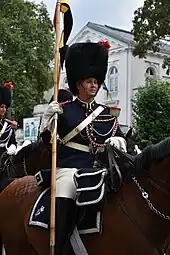
Two units in Belgium presently use the bearskin cap, the Belgian Royal Escort (since 1938), of the Belgian Federal Police;[10] and the Regiment Carabiniers Prins Boudewijn – Grenadiers of the Belgian Armed Forces Land Component.
Until 1914, bearskins were worn in parade uniform by the 'Régiment des Grenadiers' of the Belgian Army.[11] Bearskins were used in peacetime manoeuvres until around 1900, the bearskins were left in barracks upon mobilisation in August 1914, and German troops occupying Brussels reportedly took many as souvenirs. The Regiment of Grenadiers' modern successor, the Regiment Carabiniers Prins Boudewijn – Grenadiers has readopted this headdress for limited ceremonial purposes.
In addition to military units, the bearskin cap is also used by the Belgian Royal Escorts, a civilian police unit. Accompanying the monarch on ceremonial occasions, the duties of the escort unit were previously held by the Gendarmerie, a paramilitary unit of the Belgian Armed Forces that was disbanded in 1992. The present Royal Escort Unit wears the pre–1914 full dress uniform of the defunct Gendarmerie, including its bearskin cap.
Canada
The bearskin caps used by the Canadian Armed Forces are of black fur and include a coloured plume (hackle) on the side of the bearskin and a gold-coloured chin strap. The Canadian Forces Dress Instructions authorise the use of bearskins for all its foot guards and fusilier regiments.[12]
In addition to foot guards and fusiliers, two line infantry regiments are also authorised to wear a bearskin cap with their ceremonial full-dress uniform: the Royal 22e Régiment (R22eR) and the Royal Regiment of Canada (RRegtC).[12] Usage of the bearskin cap by the R22eR is attributed to its historical regimental alliance with the British Army's Royal Welch Fusiliers,[13] while the use of bearskins by the RRegtC is attributed to the regiment's historical lineage from The Royal Grenadiers of the Canadian Militia.[14]
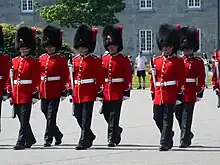
Bearskins used by fusilier regiments and the R22eR have their unit's cap badge at the front of the bearskin, while those of foot guards and the RRegtC do not have cap badges.
The following is a list of regiments whose members are authorised to wear a bearskin cap with their full dress uniform, along with the colour used on the unit's plume:
- The Royal 22e Régiment, scarlet plume[12]
- The Governor General's Foot Guards, scarlet plume[15]
- The Canadian Grenadier Guards, white plume[16]
- The Royal Regiment of Canada, scarlet over white plume
- Les Fusiliers du St-Laurent, white plume[12]
- Les Fusiliers Mont-Royal, white plume[12]
- The Princess Louise Fusiliers, grey plume[12][note 1]
- Les Fusiliers de Sherbrooke, white plume[12]
Additionally, the military band of a unit that is authorised to wear the bearskin cap is also allowed to wear it as a part of their ceremonial uniform. These bands include The Band of The Royal Regiment of Canada, La Musique du Royal 22e Régiment, and the Governor General's Foot Guards Band. In addition to these units, the drum major of the Royal Highland Fusiliers of Canada Band[note 2] are also authorised to wear the bearskin.
Denmark
.jpg.webp)
Bearskins were introduced to make guardsmen appear taller and more intimidating. The headgear was first adopted by the guard in 1805.[17] Bearskins remain in use as a part of the Royal Danish Army's Royal Life Guards' full dress uniform. The Royal Life Guards are foot guards whose duties includes providing the guard for the Danish monarchy.
Italy
Two units within the Italian Army's Granatieri di Sardegna Mechanised Brigade use the bearskin cap as a part of its ceremonial uniform, the 1st Granatieri di Sardegna Regiment, and the 8th Cavalry Regiment Lancieri di Montebello. As opposed to real bearskin, the bearskin caps of both regiments uses artificial fur.[1]
Kenya
Bearskins are used by members of the Kenya Army Band of the Kenya Defence Forces as a part of their ceremonial uniform.[1]
Netherlands
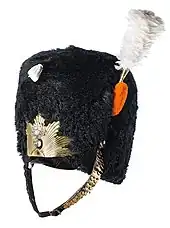
One unit of the Royal Netherlands Army uses the bearskin cap as a part of its ceremonial uniform, the Grenadiers' and Rifles Guard Regiment.[10]
Spain
One company of the 1st King's Immemorial Infantry Regiment, which during ceremonies, is authorised to wear grenadier uniforms of the Charles III period, uses bearskins.
Sri Lanka
Presently the military band of the Sri Lanka Artillery uses the bearskin cap as a part of its ceremonial uniform.
Sweden

Presently, the grenadier company of the Swedish Army's Life Guards wears a bearskin cap as a part of its ceremonial uniform. The bearskin is made out of nylon as opposed to real bearskin.[1]
Usage of the bearskin by the Life Guards originates with its predecessor unit, Svea Life Guards. The unit was eventually merged with the Swedish Life Guard Dragoons in 2000 to form the present Life Guards unit. Usage of the bearskin with the Svea Life Guards dates back to 1823, when Alexander I of Russia presented Charles XIV of Sweden a bearskin cap as a gift to be used by the Svea Life Guards.
United Kingdom
In 1768, the long cloth caps worn by grenadiers were discontinued, and bearskin caps introduced.[18] Following the Battle of Waterloo, all members of the newly named Grenadier Guards were permitted to wear the bearskin.[19] This privilege had previously been restricted to the grenadier company of the regiment.[20] In 1831, this distinction was extended to the other two regiments of foot guards (Coldstream and Scots) in existence at that date.[21] Bearskins were subsequently adopted by the Irish Guards and the Welsh Guards when raised in 1900 and 1915 respectively.[22] The following units and their bands have the bearskin cap as part of their full dress:
Along with these units, officers of fusilier regiments are also authorised to wear the bearskin as part of their ceremonial uniform.
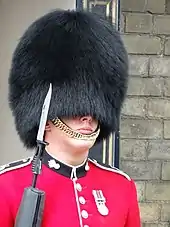
The standard bearskin for the British foot guards is 11 inches (280 millimetres) tall at the front, 16 inches (410 millimetres) to the rear, weighs 1.5 pounds (0.68 kilograms), and is made from the fur of the Canadian black bear.[23] However, an officer's bearskin is made from the fur of the Canadian brown bear, as the female brown bear has thicker, fuller fur; officers' caps are dyed black. An entire skin is used for each head-dress.[24] The British Army purchase the caps from a British hatmaker which sources its pelts at an international auction. The hatmakers purchase between 50 and 100 black bear skins each year at a cost of about £650 each.[25] If properly maintained, the caps last for decades.
Opposition
On 3 August 1888, The New York Times reported that bearskin caps might be phased out because of a shortage of bear skins. The article stated that, at that time, bearskin hats cost £7–5s each (about 35 contemporary US dollars;[26] £600 in 2007 pounds)[27] and noted "it can readily be seen what a price has to be paid for keeping up a custom which is rather old, it is true, but is practically a useless one save for the purpose of military display."[28]
In 1997, Minister for Defence Procurement Lord Gilbert said that he wanted to see bearskins phased out as soon as possible due to ethical concerns,[29] but no replacement was available at that time.
In 2005, the Ministry of Defence began a two-year test of artificial fur for the hats. The army has already replaced beaverskin caps and leopard skins, worn by some of its soldiers, with artificial materials.[30] In March 2005, Labour MP Chris Mullin called for an immediate ban on bearskins stating that they "have no military significance and involve unnecessary cruelty."[31]
Animal rights group People for the Ethical Treatment of Animals (PETA) has protested against the continued use of real fur for the guards’ bearskin caps, alleging that the animals are killed cruelly. For several years, PETA members have held demonstrations, including one at St Peter's Hill, near St Paul's Cathedral, in 2006.[32] PETA wants the fur caps to be replaced with synthetic materials, and claims that the Ministry of Defence has not done enough to find alternatives. In February 2011, Joss Stone appeared in a PETA advert targeting the Ministry of Defence, showing the 23-year-old soul singer holding a teddy bear that covers her naked body, and features the slogan 'Bear Hugs, Not Bear Caps'.[33]
United States
.jpg.webp)
Presently one military unit in the United States uses a bearskin cap as a part of their ceremonial uniform, the Second Company Governor's Foot Guard of the Connecticut State Guard, a state defence force.
In addition to the Governor's Guard, bearskin caps are also worn by the drum majors of various United States Armed Forces military bands. Bands whose drum majors are authorised to wear the bearskin cap include the United States Air Force Band, the United States Army Band, United States Army Field Band, United States Coast Guard Band, United States Marine Band, the United States Navy Band, bands of the service academies, and a variety of other divisional and fleet bands.
In addition to military units, a number of civilian marching bands also adorn their drum majors with these headpieces as opposed to their synthetic counterparts. University marching bands which were established through military means typically follow this style of dress for their drum majors. There are also several secondary school bands that use real bearskin hats.
Uruguay
The Uruguayan Army's Company of Sappers of 1837 uses the bearskin cap as a part of its ceremonial uniform as the guard of honour company of the Uruguayan Supreme Court.
Similar headgear
Other furred caps
A busby is a military headdress made of fur that appears similar to a bearskin cap. Busbies are used by a variety of hussar and artillery units. Busbies are used by hussar regiments of the Royal Netherlands Army. Busbies are also used as the full-dress headgear for the British Army's Royal Horse Artillery and hussar regiments. Similarly, the Canadian Army uses the busby as its full-dress headgear for artillery, hussar and rifle regiments.[34] In addition to hussar and artillery regiments, the First Company of the First Company Governor's Foot Guard of the Connecticut State Militia also include a bearskin (known as a "busby") as a part of their ceremonial uniform.
A sealskin cap is another furred cap similar to the bearskin cap, that is worn by the British Army's Royal Regiment of Fusiliers.[35]
Pith helmet
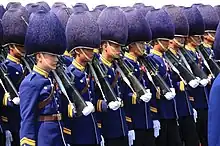
A number of units within the King's Guard of the Royal Thai Armed Forces wear a pith helmet with heavy plumes, making it broadly resemble a bearskin cap. The pith helmets are used with the unit's ceremonial full dress uniform, for occasions including the Thai Royal Guards parade held every year in December, royal coronations, funerals, and anniversaries. The colours of the plumes vary from black to pink and blue, depending on the units of the wearers, similar to the uniform facings in the Commonwealth. The majority of the units entitled to wear these headdresses are from the Army and Air Force, with two Royal Thai Marine Corps battalions also maintaining this privilege. In addition, the Royal Security Command's two guards regiments wear the pith helmet with black plumes in their full dress.
See also
Notes
- The unit is authorised to use either the bearskin cap or a Wolseley helmet along with their full dress. Members typically wear the Wolseley helmet when in full dress.
- Despite using the term fusilier in its name, the Royal Highland Fusiliers of Canada is considered a Lowland Canadian-Scottish regiment.
References
- Wharton, James. "The Bearskin: Everything you need to know". www.forces.net. Retrieved 18 January 2023.
- Mouillard, Lucien: Les Régiments sous Louis XV, Paris 1882
- Military Uniforms of the World: Preben Kannil SBN 71370482 9
- British Military Uniforms From Contemporary Pictures: W.Y.Carman Hamlyn Publishing Group 1968
- "Uniforms of the World": Richard Knotel, ISBN 0-684-16304-7.
- "Soldier faints during trooping the colour rehearsal in London heatwave – video". the Guardian. 10 June 2023. ISSN 0261-3077. Retrieved 17 July 2023.
- Mooallem, Jon (12 July 2023). "A Royal Soldier Fainted in the Heat. It Holds a Lesson for All of Us". The New York Times. ISSN 0362-4331. Retrieved 17 July 2023.
- "Check it out - Australian Army Band Melbourne - Training Command - Army". www.Defence.gov.au. Archived from the original on 7 October 2008. Retrieved 29 December 2009.
- http://www.rar.org.au/documents/3RARHistoryCom%5B%5D
- World Uniforms in Colour volume 1 — The European Nations: Rinaldo D'Ami ISBN 0-85059-031-0
- Pages 24-25 "Les Soldats de Leopold Ist et Leopold II": Guy Derie/John Pacco. Published Paul Legrain Bruxelles.
- "Annex B Royal military colleges and infantry regiments". Canadian Armed Forces Dress Instruction. Government of Canada. 11 September 2018. Retrieved 22 June 2019.
- "Officer, Royal 22e Régiment, 1930s". Canadian Military History Gateway. Government of Canada. 1 July 2017. Retrieved 14 July 2019.
- "Private, 10th Regiment Royal Grenadiers, circa 1912". Canadian Military History Gateway. Government of Canada. 1 July 2017. Retrieved 14 July 2019.
- GGFG – About Archived 7 October 2007 at the Wayback Machine
- "Canadian Army Bearskins - Maciej Swulinski". swulinski.com. Retrieved 21 January 2015.
- Petersen, Karsten Skjold (2014). Kongens klæder – Hærens uniformer og udrustning i Danmark-Norge (in Danish) (1st ed.). Slovenia: Historika. p. 331. ISBN 9788793229006.
- Illustrated Naval and Military Magazine: A Monthly Journal Devoted to All Subjects Connected with Her Majesty's Land and Sea Forces, Volumen8. W.H. Allen & Company. 1888. p. 316.
- Major R.M. Barnes, page 116 "Military Uniforms of Britain & the Empire", Sphere Books Ltd, London 1972
- Fisher, David (27 July 1989). The Grenadier Guards. p. 34. ISBN 0-85045-284-8.
- Stadden, Charles (1973). Coldstream Guards. p. 51. ISBN 0-85524-111-X.
- Carman, W.Y. (1985). Uniforms of the British Army. The Infantry Regiments. p. 29. ISBN 0-86350-031-5.
- "Britain Will Never Part with Bearskin Hats," Associated Press, 9 January 2008.
- Rachel Shields, "They're Changing Hats at Buckingham Palace To Save the Black Bear," The Independent 31 Aug. 2008.
- "People's Daily Online -- British Royal Guards criticised for wearing bearskin hats on Queen's Birthday". people.com.cn. Retrieved 21 January 2015.
- "Measuring Worth - Measures of worth, inflation rates, saving calculator, relative value, worth of a dollar, worth of a pound, purchasing power, gold prices, GDP, history of wages, average wage". measuringworth.org. Retrieved 21 January 2015.
- "Measuring Worth - Relative Value of UK Pounds". Archived from the original on 12 November 2006.
- "Bearskin hats in danger" (PDF). The New York Times. 3 August 1888. Retrieved 21 January 2015.
- Buckingham guards' bearskins face their Waterloo Archived 26 July 2008 at the Wayback Machine
- "PETA roars over U.K. army's hats - World news - Weird news - NBC News". NBC News. Retrieved 21 January 2015.
- Call to ban British royal guards from wearing bearskin hats gains support
- "BBC News - UK - England - Naked demo against bearskin hats". News.BBC.co.uk. BBC News. 21 May 2006. Retrieved 21 January 2015.
- Joss Stone goes nude for a PETA campaign against the use of bear fur for military hats
- "Annex A Armoured regiments". Canadian Armed Forces Dress Instruction. Government of Canada. 11 September 2018. Retrieved 22 June 2019.
- A Dictionary of Military Uniform: W.Y.Carman ISBN 0-684-15130-8
External links
![]() Media related to Bearskin caps at Wikimedia Commons
Media related to Bearskin caps at Wikimedia Commons